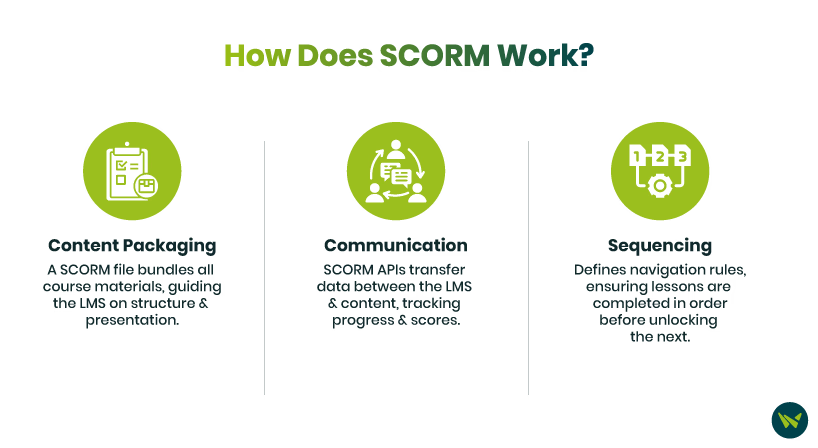
Have you ever wondered what SCORM is and why it is essential for e-learning? SCORM, or Sharable Content Object Reference Model, is the industry standard that ensures e-learning content integrates seamlessly with Learning Management Systems (LMS). It enables organizations to create, share, and track training programs effortlessly across platforms, providing a consistent and efficient learning experience.
In this blog, we’ll explore everything you need to know about SCORM – what it is, how it works, and why it’s essential for modern e-learning. Whether you’re a content creator, LMS administrator, or someone curious about e-learning standards, this guide has you covered.

The Shareable Content Object Reference Model (SCORM) is a set of technical standards for e-learning software that ensures content is compatible with different learning management systems. It basically tells how to make a course that works well with any platform. Simply put, it gives a detailed description of the course structure and how it interacts with LMS.
Now that you know SCORM's meaning, let's move on to how it works. SCORM works by providing technical standards across three main categories that dictate how the courses should be packaged, delivered, and tracked.

What Is A SCORM File?
A SCORM file, also known as SCORM package, SCORM course, or SCORM module, is a ZIP file that includes e-learning content in the form of JavaScript, HTML, and multimedia elements. It uses a standardized SCORM file type to ensure compatibility with LMS. A SCORM file type also contains a manifest file, which specifies the structure and behavior of the content.
Every SCORM package should include these key components:
By adhering to the SCORM file format, e-learning modules can be seamlessly imported, launched, and tracked.
SCORM compliance and standards form the foundation of modern e-learning by ensuring interoperability, consistency, and efficiency in delivering content. Here is everything you need to know about SCORM compliance:
What Is SCORM Compliance?
SCORM compliance means your course adheres to the industry standard for communicating between learning management systems and e-learning content. In simple words, SCORM compliance states that your e-learning content meets the SCORM standard. It ensures that courses can be delivered, tracked, and measured across any SCORM-compliant LMS.
SCORM Compliant Learning Management Systems
When you are ready to deliver online courses, you might need an LMS, but choosing the best fit can be daunting. With numerous platforms available on the market, you might want to have a SCORM compliant LMS. To help you get started, we have listed a few of the LMS platforms:

TalentLMS
TalentLMS is a versatile platform that supports SCORM-compliant courses, making it easy for businesses and educators to upload, manage, and track training programs. Its user-friendly interface and extensive features cater to organizations of all sizes.
Traliant
Known for its focus on compliance training, Traliant supports SCORM standards to deliver engaging and interactive e-learning content. It offers tracking and reporting capabilities to meet regulatory requirements.
Skyprep
Skyprep is a cloud-based LMS designed to simplify employee training. Its SCORM compliance ensures easy integration with various e-learning content formats, enabling smooth delivery and detailed performance tracking.
Skillsoft
Skillsoft specializes in offering a vast library of pre-built SCORM-compliant courses. Its platform allows businesses to implement scalable training solutions and track learner progress efficiently.
There are plenty of benefits of SCORM, which is why it is among the most adopted technical standards in the e-learning industry. Here are a few of them:

Why SCORM Compliance Matters For LMS
SCORM compliance is crucial for LMS platforms because it ensures seamless functionality and compatibility across different systems. With SCORM-compliant content, organizations can switch LMS providers without losing access to their learning materials, as these modules are designed to work universally. This flexibility also allows content to be reused across various departments, saving time and resources.
Additionally, SCORM compliance guarantees a consistent and standardized learning experience for users, regardless of the platform. Furthermore, SCORM-compliant LMSs track learners’ progress and performance, providing valuable insights into course completion rates and learner engagement, which are essential for optimizing training strategies.
There are three versions of SCORM, and they include:
- SCORM 1.1
- SCORM 1.2
- SCORM 2004 (which was formerly known as 1.3)
SCORM 2004
It is the latest version of the standard that is used today. This version has improved reporting variables, capabilities, and sequencing. The only drawback is that a few LMS vendors support it due to its complexity.
SCORM 1.2
This is the most commonly supported version of SCORM, mainly because it is easy and simple to work with.
SCORM tools and platforms streamline the creation, management, and delivery of SCORM e-learning content. Some of the popular tools include Articulate 360, Adobe Captivate, and iSpring Suite, which enable course designers to create engaging SCORM-compliant courses with ease.
Moreover, platforms such as TalentLMS, Moodle, and Docebo support the seamless integration, tracking, and reporting of SCORM packages. As far as cloud-based solutions are concerned, tools like SCORM Cloud facilitate the testing and distribution of SCORM content across various LMS environments, ensuring compatibility and functionality. These tools and platforms empower organizations to efficiently manage and deliver high-quality e-learning experiences.
Ready to get started with SCORM? Explore SCORM-compliant LMS platforms today and transform your e-learning strategy.
What Is SCORM Cloud?
SCORM Cloud is a useful tool that helps ensure the e-learning content is effective and easily accessible to provide an enriching experience. This cloud-based platform hosts, tests, and distributes SCORM packages to make sure that the learning content is operable across different platforms.

